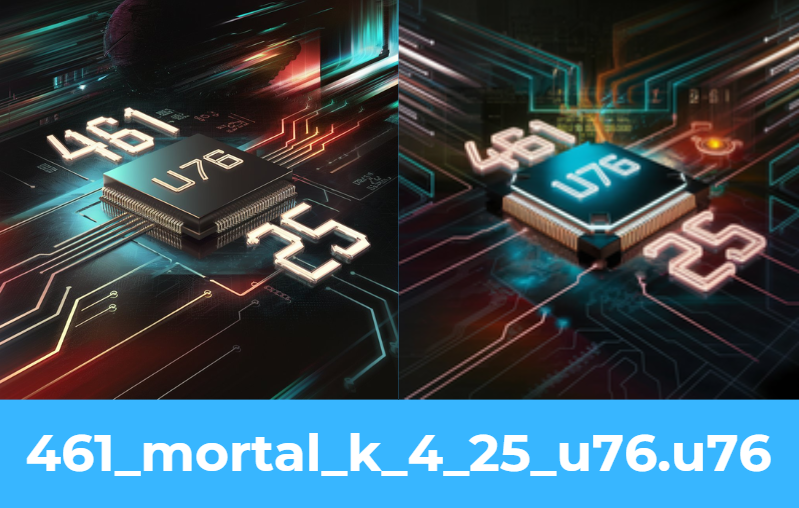In this comprehensive guide, we dive deep into the world of 461_mortal_k_4_25_u76.u76, a vital ROM file integral to the arcade classic Mortal Kombat 4.
This article is designed for emulation enthusiasts, retro gaming historians, and technical experts who wish to understand the intricacies of arcade preservation. We cover everything from its background and technical specifications to legal considerations and future trends, ensuring you have the most valuable resource at your fingertips.
Introduction to 461_mortal_k_4_25_u76.u76
461_mortal_k_4_25_u76.u76 is not just another file in the vast landscape of arcade emulation; it is a cornerstone for preserving the authentic experience of Mortal Kombat 4. This ROM file, originating from the arcade system developed by Midway, plays a crucial role in how emulators like MAME recreate the original hardware environment. Its unique naming structure, indicating chip location and cabinet configuration, helps enthusiasts and developers alike maintain accuracy when emulating one of the most iconic fighting games in arcade history.
By understanding 461_mortal_k_4_25_u76.u76, you gain insights into the meticulous process of digital preservation, where every byte of data contributes to replicating the original arcade experience. This guide provides not only technical details but also practical steps to integrate and optimize this file within modern emulation frameworks.
Background of Mortal Kombat 4 Arcade Hardware
Mortal Kombat 4 revolutionized the arcade scene in the late 1990s with its cutting-edge graphics and gameplay mechanics. The hardware behind this game was specifically engineered to deliver fast-paced, interactive action, which set a new standard for arcade fighting games. The development of 461_mortal_k_4_25_u76.u76 is a direct result of this advanced technology.
Historically, arcade hardware was designed with specialized chips and custom circuitry, and each ROM file had a designated role in the functioning of the machine. For example, the file we focus on today is linked to a specific chip location, denoted by “U76,” and hints at a particular cabinet configuration with the “25” in its name. Such details ensure that every element of the game’s operation, from graphics rendering to audio processing, is faithfully reproduced when emulated.
This background illustrates how 461_mortal_k_4_25_u76.u76 is more than a file—it is a critical piece of the puzzle that helps keep the legacy of Mortal Kombat 4 alive.
Detailed Technical Specifications
Understanding the technical specifications of 461_mortal_k_4_25_u76.u76 is essential for both developers and enthusiasts. This section explains the file format, its components, and why each technical detail matters in the emulation process.
The file itself is 8,192 bytes in size and is verified through industry-standard checksum methods, ensuring data integrity. The CRC32 checksum for 461_mortal_k_4_25_u76.u76 is d4432af9, and its SHA1 hash is 44a4b114f9b2075fdc611c011123a37b99458752. These values confirm that the file has not been tampered with and is a faithful reproduction of the original data used in the arcade machine.
To present this information clearly, consider the following table summarizing the key technical details:
| Parameter | Description |
|---|---|
| File Name | 461_mortal_k_4_25_u76.u76 |
| Size | 8,192 bytes |
| CRC32 Checksum | d4432af9 |
| SHA1 Hash | 44a4b114f9b2075fdc611c011123a37b99458752 |
| Chip Location | U76 (specific to the arcade board design) |
These technical metrics are indispensable for ensuring that the file functions correctly within any emulation setup.
Emulation and Integration in MAME
For many enthusiasts, the primary use of 461_mortal_k_4_25_u76.u76 is within the Multiple Arcade Machine Emulator (MAME). MAME is a powerful tool that allows users to experience arcade games exactly as they were originally intended. Integrating 461_mortal_k_4_25_u76.u76 into MAME involves a series of well-documented steps that ensure optimal performance and authenticity.
The process begins with setting up MAME and placing the ROM file in the appropriate directory. Users must ensure that the file structure mirrors that of the original arcade hardware, so that each ROM is correctly identified during the emulation process. Detailed configuration settings within MAME help match the hardware emulation with the specific needs of Mortal Kombat 4.
A step-by-step approach might include:
- Installing the latest version of MAME.
- Creating or verifying the directory structure for ROM files.
- Placing 461_mortal_k_4_25_u76.u76 in the correct folder corresponding to Mortal Kombat 4.
- Adjusting MAME configuration settings to optimize compatibility.
In addition to these steps, the emulation community often shares best practices and troubleshooting tips through forums and detailed guides, ensuring that even newcomers can successfully run the game.
Legal Considerations and Ethical Use
Emulation is a fascinating field, but it also comes with a set of legal and ethical challenges. The use of 461_mortal_k_4_25_u76.u76 must adhere to copyright laws and intellectual property rights, as ROM files are considered protected content. It is essential for users to obtain these files through legitimate means and to respect the rights of the original developers and copyright holders.
Ethically, the community emphasizes the preservation of arcade history. This means that while emulation serves as a way to enjoy and study classic games, it should not be used for unauthorized distribution or commercial exploitation. By following established guidelines and legal frameworks, enthusiasts can ensure that they contribute to the preservation of gaming history in a responsible manner.
Troubleshooting and Optimization
Even with careful setup, users may encounter issues when working with 461_mortal_k_4_25_u76.u76 in an emulation environment. Common challenges include compatibility errors, performance lags, or discrepancies in graphical rendering. Addressing these problems often involves a combination of technical adjustments and community-sourced advice.
For instance, if you encounter performance issues, consider the following optimization techniques:
- Verify that your MAME configuration matches the specific hardware requirements of Mortal Kombat 4.
- Update your emulator to the latest version to benefit from recent patches and improvements.
- Consult community forums for insights on resolving specific issues related to 461_mortal_k_4_25_u76.u76.
Troubleshooting may also involve checking the integrity of the ROM file using checksum tools, ensuring that no data corruption has occurred. By methodically addressing each potential problem area, users can enjoy a smoother and more authentic emulation experience.
The Future of Arcade Emulation and ROM Preservation
The field of arcade emulation is continuously evolving, driven by advancements in technology and a growing community of dedicated enthusiasts. Looking forward, 461_mortal_k_4_25_u76.u76 will continue to play a significant role in preserving the legacy of arcade games like Mortal Kombat 4.
Emerging trends in emulation include the integration of artificial intelligence and machine learning to improve error correction and optimize performance. Additionally, ongoing initiatives aimed at digital preservation are ensuring that classic arcade games are accessible to future generations. As technology advances, the methods for verifying, cataloging, and emulating ROM files will become even more sophisticated, further solidifying the importance of detailed guides such as this one.
Appendices and Additional Resources
For readers seeking more technical insights or further reading, this guide offers supplementary materials that provide additional context and technical details.
A glossary of key technical terms is available to help demystify complex jargon associated with arcade emulation. Furthermore, curated lists of external resources, including research papers, official documentation, and active community forums, can enhance your understanding of 461_mortal_k_4_25_u76.u76 and its role in the broader field of digital preservation.
Below is an example list of useful resources:
- Official MAME documentation and user guides.
- Community forums and discussion boards focused on arcade emulation.
- Technical papers on ROM preservation and digital archiving.
- Online tools for verifying ROM file integrity.
These additional resources ensure that whether you are a beginner or an advanced user, you have access to the necessary tools and knowledge to further your expertise.
Conclusion
In summary, 461_mortal_k_4_25_u76.u76 is a critical component in the realm of arcade emulation, representing both the technical ingenuity of Mortal Kombat 4 and the broader efforts to preserve arcade history.
This guide has provided an in-depth look at its background, technical specifications, integration into MAME, legal and ethical considerations, troubleshooting strategies, and the future of digital preservation. By understanding and utilizing this guide, you are better equipped to engage with the rich legacy of arcade gaming and contribute to the ongoing preservation of these digital treasures.
Thank you for exploring our comprehensive guide. We hope it serves as an invaluable resource in your journey through arcade emulation and helps you maintain an authentic connection with the past while embracing future innovations.
Frequently Asked Questions (FAQs)
What is the origin of arcade ROM file naming conventions, and how does it relate to 461_mortal_k_4_25_u76.u76?
The naming conventions for arcade ROM files have evolved over decades to assist engineers and technicians in identifying specific components of an arcade system. In the case of 461_mortal_k_4_25_u76.u76, each segment of the file name carries distinct meaning. While “mortal_k_4” clearly ties the file to the Mortal Kombat 4 game, other parts such as “461” or “25” often reflect internal inventory numbers or denote a particular cabinet configuration.
The “U76” portion, for example, signifies the chip’s position on the original circuit board, a practice that has helped maintenance teams quickly locate and verify hardware components in arcade systems. This structured naming methodology is a legacy of early hardware design practices that continues to support both preservation efforts and technical restorations today.
How are rare ROM files like 461_mortal_k_4_25_u76.u76 preserved by the retro gaming community?
Preservation of vintage ROM files is a passion and priority for retro gaming enthusiasts. Unlike many modern digital assets, these files often come from aging hardware that is susceptible to physical degradation. Dedicated archivists and hobbyist groups work collaboratively to digitize, verify, and store these files in secure, redundant repositories.
They employ specialized software and hardware tools to extract data from deteriorating arcade boards, ensuring that even if the physical machines are lost, their digital footprints remain intact. Many of these initiatives also include the creation of online databases where verified ROM files are cataloged with detailed metadata, aiding future restoration and emulation efforts.
What role do hardware enthusiasts and ROM hackers play in maintaining the accuracy of 461_mortal_k_4_25_u76.u76?
Beyond simple preservation, a vibrant community of hardware enthusiasts and ROM hackers actively engages in verifying and enhancing the accuracy of classic arcade files like 461_mortal_k_4_25_u76.u76. These experts conduct meticulous comparisons between original arcade board dumps and existing digital copies, often using state-of-the-art checksum tools and error-correcting algorithms.
Their work not only ensures that the ROM file faithfully represents the original hardware data but also supports the development of improved emulation software. Contributions from these individuals often appear in community forums and dedicated digital preservation projects, where they share insights and novel techniques that push the boundaries of retro computing.
How has the legal landscape evolved regarding the distribution and use of 461_mortal_k_4_25_u76.u76 outside of authorized emulation contexts?
The legal environment surrounding arcade ROM files has been in flux for many years, influenced by ongoing debates about copyright, digital ownership, and preservation rights. Although many in the community view files like 461_mortal_k_4_25_u76.u76 as cultural artifacts, copyright laws continue to impose restrictions on their distribution and use.
Recent years have seen an increase in digital rights management efforts and stricter enforcement actions by rights holders. This evolving legal framework means that while enthusiasts are encouraged to preserve and study these files, caution and adherence to local laws are essential, especially when it comes to sharing or repurposing digital assets for commercial or public use.
Are there innovative applications or research projects that have utilized 461_mortal_k_4_25_u76.u76 beyond traditional arcade emulation?
Indeed, the use of 461_mortal_k_4_25_u76.u76 has extended into innovative research and creative projects that go well beyond typical emulation. Academics and technologists have harnessed these vintage ROM files to explore digital preservation methodologies, study the evolution of embedded systems, and even develop modern retro-computing art installations. Some projects focus on comparing historical hardware performance with modern emulation, offering insights into technological progression.
Others use these ROM files as case studies in digital forensics, examining how data integrity is maintained over decades. This crossover between entertainment, research, and digital art underscores the multifaceted value of preserving such technical relics.
Other Posts Like 461_mortal_k_4_25_u76.u76
Ultimate Guide to Marla Heyman: Biography, Career, and Impact
The Ultimate Guide to wikîpedia: Everything You Need to Know











